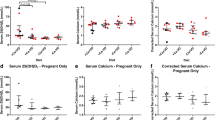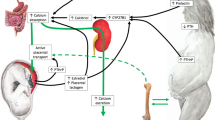Abstract
There is increasing evidence of vitamin D insufficiency in women of child-bearing age and their infants. This study examined the effect of maternal vitamin D deficiency on nephron endowment in rat offspring (n = 7 per group). Sprague–Dawley dams were fed either a vitamin D deplete diet or a vitamin replete (control) diet prior to pregnancy, during pregnancy and throughout lactation. At 4 weeks of age the offspring were weaned and maintained on their respective diets until they were killed at 7 weeks. In the fixed right kidney, kidney volume, renal corpuscle volume and nephron number were stereologically determined. There was no difference between groups in body weight, kidney weight or kidney volume. There was a significant 20% increase in nephron number in kidneys of vitamin D deplete offspring (vitamin D deficient, 29,000 ± 1,858, control, 23,330 ± 1,828; P = 0.04). This was accompanied by a significant decrease in renal corpuscle size in the vitamin D deplete group compared with the controls (6.125 ± 0.576 × 10−4 mm3 and 8.178 ± 0.247 × 10−4 mm3, respectively; P = 0.03). We concluded that maternal vitamin D deficiency in rats appears to stimulate nephrogenesis. Whether this confers a renal functional advantage or not is unknown.



Similar content being viewed by others
References
Dusso AS, Brown AJ, Slatopolsky E (2005) Vitamin D. Am J Physiol Renal Physiol 289:F8–F28
Holick MF (2006) High prevalence of vitamin D inadequacy and implications for health. Mayo Clin Proc 81:353–373
Robinson JK (2005) Sun exposure, sun protection and vitamin D. JAMA 294:1541–1543
Bassir M, Laborie S, Lapillonne A, Claris O, Chappuis MC, Salle BL (2001) Vitamin D deficiency in Iranian mothers and their neonates: a pilot study. Acta Paediatr 90:577–579
Grover SR, Morley R (2001) Vitamin D deficiency in veiled or dark-skinned pregnant women. Med J Aust 175:251–252
Andiran N, Yordam N, Ozon A (2002) Risk factors for vitamin D deficiency in breast-fed newborns and their mothers. Nutrition 18:47–50
Nesby-O’Dell S, Scanlon KS, Cogswell ME, Gillespie C, Hollis BW, Looker AC, Allen C, Doughertly C, Gunter EW, Bowman BA (2002) Hypovitaminosis D prevalence and determinants among African American and white women of reproductive age: third National Health and Nutrition Examination Survey, 1988–1994. Am J Clin Nutr 76:187–192
Tare M, Parkington HC, Morley R (2006) Vitamin D in pregnancy and offspring health. Adv Exp Med Biol 573:195–203
Barker DJ, Osmond C (1986) Infant mortality, childhood nutrition, and ischaemic heart disease in England and Wales. Lancet 1:1077–1081
Barker DJ, Winter PD, Osmond C, Margetts B, Simmonds SJ (1989) Weight in infancy and death from ischaemic heart disease. Lancet 2:577–580
Rich-Edwards JW, Stampfer MJ, Manson JE, Rosner B, Hankinson SE, Colditz GA, Willett WC, Hennekens CH (1997) Birth weight and risk of cardiovascular disease in a cohort of women followed up since 1976. BMJ 315:396–400
Hoy WE, Rees M, Kile E, Mathews JD, Wang Z (1999) A new dimension to the Barker hypothesis: low birth weight and susceptibility to renal disease. Kidney Int 56:1072–1077
Newsome CA, Shiell AW, Fall CH, Phillips DI, Shier R, Law CM (2003) Is birth weight related to later glucose and insulin metabolism?—A systematic review. Diabet Med 20:339–348
Gluckman PD, Cutfield W, Hofman P, Hanson MA (2005) The fetal, neonatal, and infant environments—the long-term consequences for disease risk. Early Hum Dev 81:51–59
Hincliffe SA, Sargent PH, Howard CV, Chan YF, Van Velzen D (1991) Human intrauterine renal growth expressed in absolute number of glomeruli assessed by the dissector method and Cavalieri principle. Lab Invest 64:777–784
Larsson R, Aperia A, Wilton P (1980) Effect of normal development on compensatory renal growth. Kidney Int 18:29–35
Keller G, Zimmer G, Mall G, Ritz E, Amann K (2003) Nephron number in patients with primary hypertension. N Engl J Med 348:101–108
Hoy WE, Hughson MD, Singh GR, Douglas-Denton R, Bertram JF (2006) Reduced nephron number and glomerulomegaly in Australian Aborigines: a group at high risk for renal disease and hypertension. Kidney Int 70:104–110
Nenov VD, Taal MW, Sakharova OV, Brenner BM (2000) Multi-hit nature of chronic renal disease. Curr Opin Nephrol Hypertens 9:85–97
Vehaskari VM, Aviles DH, Manning J (2001) Prenatal programming of adult hypertension in the rat. Kidney Int 59:238–245
Wintour EM, Moritz KM, Johnson K, Ricardo S, Samuel CS, Dodic M (2003) Reduced nephron number in adult sheep, hypertensive as a result of prenatal glucocorticoid treatment. J Physiol 549:929–935
Gilbert JS, Lang AL, Grant AR, Nijland MJ (2005) Maternal nutrient restriction in sheep: hypertension and decreased nephron number in offspring at 9 months of age. J Physiol 565:137–147
Zimanyi MA, Bertram JF, Black MJ (2004) Does a nephron deficit in rats predispose to salt-sensitive hypertension? Kidney Blood Press Res 27:239–247
Dickinson H, Walker DW, Wintour EM, Moritz K (2007) Maternal dexamethasone treatment at midgestation reduces nephron number and alters renal gene expression in the fetal spiny mouse. Am J Physiol Regul Integr Comp Physiol 292:R453–R461
Zimanyi MA, Denton KM, Forbes JM, Thallas-Bonke V, Thomas MC, Poon F, Black MJ (2006) A developmental nephron deficit in rats is associated with increased susceptibility to a secondary renal injury due to advanced glycation end-products. Diabetologia 49:801–810
Neugarten J, Kasiske B, Silbiger SR, Nyengaard JR (2002) Effects of sex on renal structure. Nephron 90:139–144
Gundersen HJ, Bendtsen TF, Korbo L, Marcussen N, Moller A, Nielsen K, Nyengaard JR, Pakkenberg B, Sorensen FB, Vesterby A (1988) Some new, simple and efficient stereological methods and their use in pathological research and diagnosis. APMIS 96:379–394
Black MJ, Briscoe TA, Dunstan HJ, Bertram JF, Johnston CI (2001) Effect of angiotensin-converting enzyme inhibition on renal filtration surface area in hypertensive rats. Kidney Int 60:1837–1843
Black MJ, Briscoe TA, Constantinou M, Kett MM, Bertram JF (2004) Is there an association between level of adult blood pressure and nephron number or renal filtration surface area and level of adult blood pressure? Kidney Int 65:582–588
Bertram JF (1995) Analyzing renal glomeruli with the new stereology. Int Rev Cytol 161:111–172
Brown AJ, Dusso A, Slatopolsky E (1999) Vitamin D. Am J Physiol Renal Physiol 277:F157–F175
Morley R, Carlin JB, Pasco JA, Wark JD (2006) Maternal 25-hydroxyvitamin D and parathyroid hormone concentrations and offspring birth size. J Clin Endocrinol Metab 91:906–912
Hughson M, Farris AB, Douglas-Denton R, Hoy WE, Bertram JF (2003) Glomerular number and size in autopsy kidneys: the relationship to birth weight. Kidney Int 63:2113–2122
Gubhaju L, Black MJ (2005) The baboon as a good model for studies of human kidney development. Pediatr Res 58:505–509
Li YC, Kong J, Wei M, Chen ZF, Liu SQ, Cao L-P (2002) 1,25-Dihydroxyvitamin D(3) is a negative endocrine regulator of the renin-angiotensin system. J Clin Invest 110:229–238
Li YC, Qiao G, Uskokovic M, Xiang W, Zheng W, Kong J (2004) Vitamin D: a negative endocrine regulator of the renin-angiotensin system and blood pressure. J Steroid Biochem Mol Biol 89–90:387–392
Kong J, Li YC (2003) Effect of ANG II type I receptor antagonist and ACE inhibitor on vitamin D receptor-null mice. Am J Physiol Regul Integr Comp Physiol 285:R255–R261
Tufro-McReddie A, Romano LM, Harris JM, Ferder L, Gomez RA (1995) Angiotensin II regulates nephrogenesis and renal vascular development. Am J Physiol 269:F110–F115
Woods LL, Rasch R (1998) Perinatal ANG II programs adult blood pressure, glomerular number and renal function in rats. Am J Physiol 275:R1593–R1599
Woods LL, Ingelfinger JR, Nyengaard JR, Rasch R (2001) Maternal protein restriction suppresses the newborn renin-angiotensin system and programs adult hypertension in rats. Pediatr Res 49:460–467
Somjen E, Earon Y, Harell S, Shimshoni Z, Weisman Y, Harell A, Kaye AM, Binderman I (1987) Developmental changes in responsiveness to vitamin D metabolites. J Steroid Biochem 27:807–813
Makibayashi K, Tatematsu M, Hirata M, Fukushima N, Kusano K, Ohashi S, Abe H, Kuze K, Fukatsu A, Kita T, Doi T (2001) A vitamin D analog ameliorates glomerular injury on rat glomerulonephritis. Am J Pathol 158:1733–1741
Panichi V, Migliori M, Taccola D, Filippi C, De Nisco L, Giovannini L, Palla R, Tetta C, Camussi G (2001) Effects of 1,25(OH)2D3 in experimental mesangial proliferative nephritis in rats. Kidney Int 60:87–95
Rogers SA, Droege D, Dusso A, Hammerman MR (2004) Incubation of metanephroi with vitamin D3 increases numbers of glomeruli. Organogenesis 1:52–54
Acknowledgements
This study was supported by funding from the Clive and Vera Ramaciotti Foundation. The authors gratefully acknowledge Obioha Ukoumunne for advice in the statistical analyses.
Author information
Authors and Affiliations
Corresponding author
Rights and permissions
About this article
Cite this article
Maka, N., Makrakis, J., Parkington, H.C. et al. Vitamin D deficiency during pregnancy and lactation stimulates nephrogenesis in rat offspring. Pediatr Nephrol 23, 55–61 (2008). https://doi.org/10.1007/s00467-007-0641-9
Received:
Revised:
Accepted:
Published:
Issue Date:
DOI: https://doi.org/10.1007/s00467-007-0641-9




